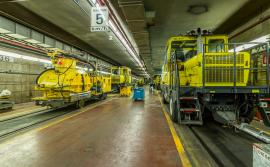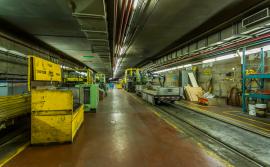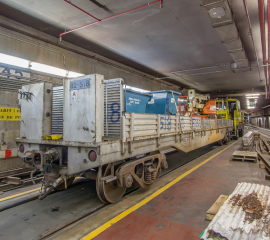Dismantling of buildings at 4636–4670 Décarie Boulevard
These buildings must be dismantled for safety reasons, as they are in an advanced state of deterioration. The work started in December 2024.
Once the buildings have been dismantled, we will create a temporary public space to keep the site safe and in good condition. This will be done in spring and summer 2025.The Côte-des-Neiges–Notre-Dame-de-Grâce borough will be responsible for setting up the space and developing an urban agriculture project there until the new Northwest Attachment Centre (NAC) project is completed.
Do you live or run a business in the area?
Stay informed of the project’s progress and other particular events by signing up for the electronic newsletter.
- Most of the work will take place Monday to Friday between 7 a.m. and 7 p.m., but sometimes it may need to continue on weekends, in compliance with municipal by-laws, to stay on schedule.
- The work has been planned to minimize disturbances and impact on the local community. We will use mitigation measures specific to the worksite and the type of working being done.
- Most of the work will take place Monday to Friday between 7 a.m. and 7 p.m., but sometimes it may need to continue on weekends, in compliance with municipal by-laws, to stay on schedule.
- The work has been planned to minimize disturbances and impact on the local community. We will use mitigation measures specific to the worksite and the type of working being done.
- Depending on where you live, you may hear noise or feel vibrations during some stages of the work, particularly during demolition of the foundation.
- During the dismantling, the buildings will be sprayed with water to control dust. The alley and the section of Décarie Boulevard near the worksite will be cleaned on a regular basis.
- An independent consulting firm will survey all buildings around the worksite to document their condition before and after the work. Property owners affected will be notified accordingly.
We are reviewing the NAC project definition with our institutional partners to ensure that the current design is cost-effective and suits our asset maintenance needs.
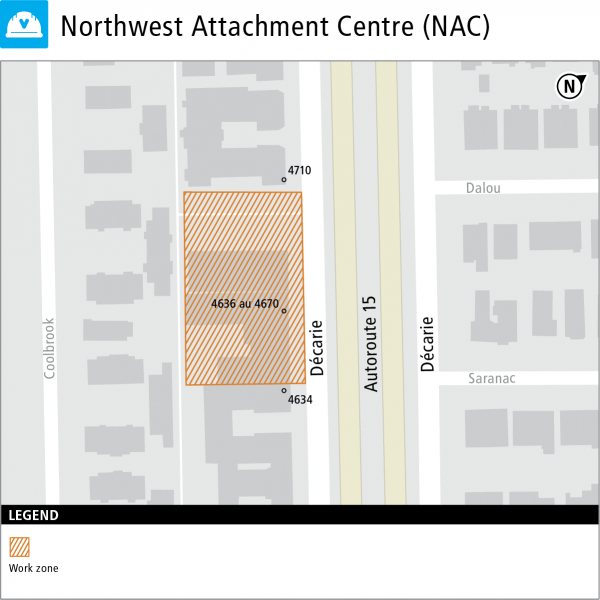
FAQ
The Northwest Attachment Centre (NAC) project will involve constructing a new mainly underground infrastructure needed to maintain the métro network. By adding this attachment centre, the STM aims to reduce its asset maintenance deficit and ensure the longevity of its métro network. The project is also needed to prepare for the Blue line extension, as the five new stations will require maintenance for decades to come.
In September 2022, we informed you that we needed to update the planning of the Northwest Attachment Centre (NAC) project before moving forward. The planning phase is still underway. The municipal authorities have granted us the authorization to demolish the buildings located at 4636 to 4670, boulevard Décarie. Demolishing these buildings is necessary for safety reasons, due to their advanced state of deterioration.
We plan to begin demolition in fall 2024 to minimize the impact on residents in the area. Once the schedule has been set, a notice will be sent to you before the work starts to inform you of the schedule and duration of the work. You will also be notified of the mitigation measures that we will implement to reduce the impact of the work on people living near the worksite.
Temporary public space
Once the buildings have been demolished and the site has been cleared, we will set up a temporary public space to maintain and secure the condition of the site. This will be done in collaboration with the Côte-des-Neiges–Notre-Dame-de-Grâce borough.
An attachment centre is an underground workshop where rail vehicles required for night-time tunnel and track maintenance are parked. It is also used to receive and transport construction materials needed at major station and tunnel refurbishment sites, as well as to remove construction debris from these sites.
There are currently three attachment centres in the métro network (Youville, Duvernay and Viau). The Viau attachment centre is currently being expanded to double its capacity.
Photos of the Viau attachment centre.
Building this new infrastructure is part of the STM’s strategy to reduce its asset maintenance deficit. Our métro network is ageing and requires a lot of maintenance and renovation. Some tasks can only be carried out at night, within a very narrow time window when the métro is not running. This constraint requires highly complex logistical planning.
This new gateway to the network, located at the intersection of the Blue and Orange lines, will not only increase the production capacity of night-time worksites but also reduce the travel time of vehicles on the network and increase the flexibility of logistical planning. It will allow the STM to meet the increasing demand from its large worksites, which are growing in size and number. This gain in versatility and performance will enable the STM to find a balance between regular network maintenance and service to external contractors.
The areas around métro stations are usually very densely built up, which makes it hard to find a suitable location. The STM chose this area for a number of reasons:
- It first took stock of the locations of the three existing underground workshops and determined that the northwest section of the métro network is underserved by the night tracks. It takes too long for work vehicles to get there, which reduces efficiency and creates difficulties for logistical planning.
- The area around Snowdon station is an ideal location. Placing the workshop at the intersection of the Orange and Blue lines will give plenty of flexibility to the work vehicles that have to move efficiently during the night and complete tasks within a very narrow time window.
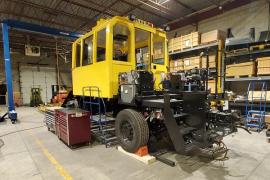 The new attachment centre will house 15 work vehicles, of which 13 will be fully electric, including a locotractor and a transport platform. These vehicles will be used to transport materials needed at major refurbishment sites, as well as specialized materials and parts for routine métro track maintenance. They will be parked roughly 33 metres below ground. The centre will also have spaces for mechanical maintenance of the vehicles.
The new attachment centre will house 15 work vehicles, of which 13 will be fully electric, including a locotractor and a transport platform. These vehicles will be used to transport materials needed at major refurbishment sites, as well as specialized materials and parts for routine métro track maintenance. They will be parked roughly 33 metres below ground. The centre will also have spaces for mechanical maintenance of the vehicles.
There will be a freight elevator to lower equipment (such as machinery) to the bottom level of the attachment centre. Two additional freight elevators will be used to load and unload materials deep underground. The freight elevators will be the first of their kind in Canada. They will reduce the building’s footprint above ground, which would not be the case if an access ramp were used.
The attachment centre will also have offices, rest areas for employees and a warehouse of specialized rail parts.
Here are some examples of work vehicles currently used in the métro network. The drawing shows a fully electric locotractor.
Once completed, around 40 people will work in the attachment centre, mostly at night. This team of specialists working in the shadows will be responsible for carrying out preventive and curative track and tunnel maintenance. They will also transport construction materials and debris and assist external contractors.
The team will include trackwalkers, who will walk the tunnels and perform inspections, and section workers, who will maintain and repair the tracks when the métro is closed. They will perform work on the tracks, guide bars and running racks, clean the invert with a vacuum train, and carry out relamping in the tunnels. There will also be a group of mechanics who will maintain the vehicles used at night by the section workers.
As vehicles will maneuver inside the building only, the NAC’s operations should cause very little nuisance. No loud equipment will be used to operate the attachment centre and no emissions or waste will be generated.
Delivery vehicles will access the attachment centre by Décarie Boulevard. Three parking spaces will be reserved outside the building, where can vehicles during peak periods. During these periods, the trucks will have to turn off their motors as required by municipal bylaws. Loading and unloading will take place inside the building only.
The Blue line extension project requires adding some operational infrastructure, including the NAC. More stations also means more maintenance, and the existing underground workshops are barely able to meet the current demand. The new attachment centre will not only help satisfy our current needs but also provide for future ones.
At no point will the NAC serve as a gateway for transporting materials for the initial construction of the five extended Blue line stations.
No, the work will not have any impact on our service to customers.
No, that is not at all possible.
Yes. A public consultation process, led by independent commissioners, took place in the fall of 2020. It is also expected that other forums for community engagement will be held in the future.
In the interest of sound management, we need to revise the planning of the Northwest Attachment Centre (NAC) project. The additional analyses currently underway will also lead to a revised schedule. However, we can confirm that no work will take place in 2023. In the meantime, the acquired buildings will be kept secure, and the STM will continue to maintain them until further notice.
Maintaining métro assets remains a priority, and we are working with the project partners to provide the necessary infrastructure to achieve this.
Sustainable development
Pursuing Envision sustainability verification
In line with our commitment to integrating sustainability best practices, we are pursuing Envision verification for this project. The Envision reference framework was developed to cover all the sustainable development aspects of an infrastructure project and each phase of its life cycle (planning, design, construction, operations and maintenance, and end-of-life). It is the top sustainable development tool in North America for major infrastructure projects such as metro and streetcar systems.
Verifying the project will allow us to:
- Consult and involve stakeholders
- Mitigate construction impacts on our community and environment
- Reduce the impacts of materials used (resource consumption and manufacturing emissions)
- Rehabilitate contaminated land
- Reduce operational impacts (residual materials, water and energy savings, noise and vibration reduction, etc.)
- Improve vegetation cover
- Improve the project’s resilience to climate change
To learn more, visit the Institute for Sustainable Infrastructure Website.
This project was made possible by funding from the governments of Canada and Quebec through the implementation of the Public Transit Infrastructure Fund.
